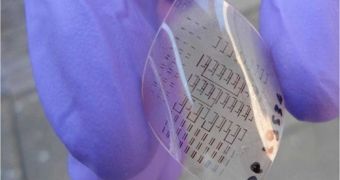Using solution-processed organic semiconductors, researchers with the University of Cambridge’s Cavendish Laboratory managed to achieve a breakthrough in the field of plastic electronics.
The team may have set the foundation for developing fast and flexible plastic electronics that consume only limited amounts of energy. There are numerous practical applications for these devices.
The research group was led by professor Henning Sirringhaus, who worked closely with colleagues Dr. Auke Kronemeijer and Dr. Enrico Gili, both physicists at the university. They say that the method they created produces these advanced electronics at high speed and low cost.
Such devices could be used in the RFID (radio frequency identification) chips that are currently employed in supermarkets or to create advanced heads-up displays (HUD) for cars and airplanes. In addition, plastic electronics could set the foundation for developing robotic skins capable of feeling.
The technology does not rely on the use of brittle silicon chips, but rather on printing the circuits on polymer-based substrates. The latter have the advantage of being flexible and transparent, experts say.
“Our research shows that it’s possible to produce electronic circuits using a new class of ambipolar organic materials that simplify considerably the fabrication process compared with more traditional materials,” Dr. Kronemeijer explains.
“Typically, to fabricate high performance plastic electronic circuits you need two different active materials. Our technology obtains the same result using only one material. This is an ink that can be printed and requires little more than room temperature to reach its peak performance,” he adds.
In order to fabricate standard, silicon-based chips, the machines involved in the process need to produce heat exceeding 1,000 degrees Celsius. This necessity is eliminated with plastic electronics, which can be created by simple printers.
“The robustness and flexibility of our new material opens up the possibility for developing all kinds of intelligent products such as clothing items that interact with their wearer,” says Dr. Kronemeijer.
Details of the new research effort, which was made possible by funds from the Engineering and Physical Sciences Research Council (EPSRC) and the Cambridge Integrated Knowledge Center (CIKC), appear in the March issue of the journal Advanced Materials.

 14 DAY TRIAL //
14 DAY TRIAL //